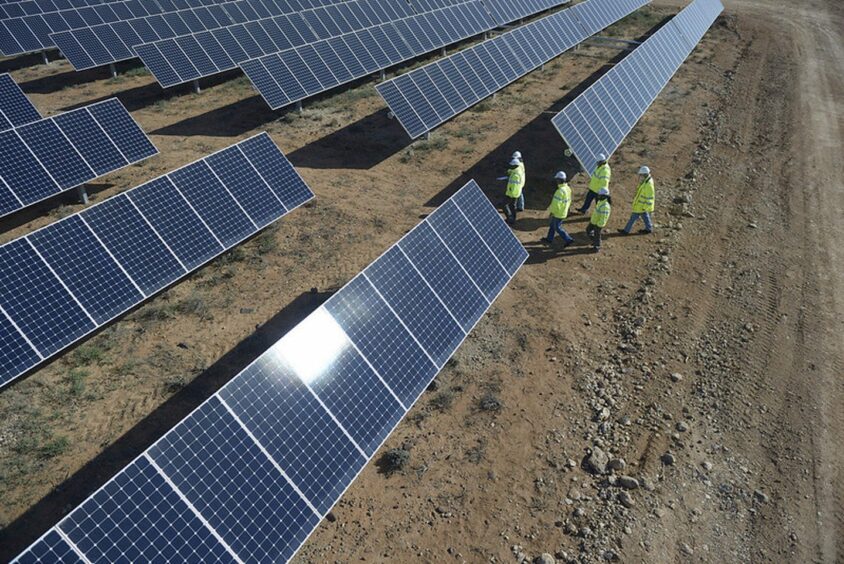
Green grids and international renewable energy are the only way to save Africa – and the world – with the alternative being a “climate abyss”.
Green grids offer one of the best ways to balance energy needs, Climate Parliament secretary general Nick Dunlop said. The group was active in the launch of the Green Grids Initiative at the COP26 event, in Glasgow last year.
“A large-scale grid can connect cities and factories with the best renewable resources,” Dunlop said. Connecting across time zones lengthens the amount of time that solar power can meet demand.
“If India connects to the Gulf states and then to North Africa, in the later parts of the evening India could draw surplus power from its west. If you want wind and solar to be reliable, you need a wide area. A single location is very variable, but a large-scale grid with inter-regional connections negates this variability.”
Dunlop explained that 92 countries had endorsed the plan, which aims to maximise connectivity and efficiency.
The African Development Bank (AfDB) has signed up to lead the African working group of green grids, which also involves the African Union.
Big plans
“There is a focus on two priority projects,” he explained. The first is the Zizabona interconnection, which would link Zimbabwe, Zambia, Botswana and Namibia.
While the plan originated as a way to trade coal power, it is evolving into a clean power project. USAID is backing a major solar project in the Namibe and Kalahari deserts, in Namibia and Botswana, which will source power for the line.
“The trick is to develop large scale power projects in the west and then ship the power east.”
The second project of interest hinges on the Inga Dam, in Congo Kinshasa. This has been controversial and development would need to be mindful of the local issues around conservation and avoiding impact on forestry and people.
“Done in the right way, there is enormous hydropower potential,” Dunlop said, generating 44 GW. “This would provide quite a lot of the power needed for Southern Africa, it could replace fossil fuels and close down coal power plants.”
Solar, wind and hydropower all offer opportunity to different parts of Africa, while there are other options as well such as geothermal.
Risk off
The weak link, though, is access to funds. Dunlop highlighted the potential for the bond market to make infrastructure investments in Africa.
“The challenge is to make investments in green grid infrastructure bankable, to make them safe and a good investment.” While the infrastructure gap is apparent, the perceptions of risk continue to keep interest rates high for African projects.
“The simplest way to tackle [worries around risk] is through guarantees,” Dunlop said, from multilateral institutions or governments. “Guarantees ensure companies get their money back. We have to do it, most African utilities are broke and aren’t seen as reliable without international support.”
At the other end of the scale from the Inga megaproject and the Zizabona link are minigrids. “Every community, not just in Africa, but everywhere should have a community grid embedded.”
Such projects allow villages to harness local renewable resources. They also provide more resilience on a local level. “With increasing extreme weather, national grids are failing,” Dunlop said, pointing to examples in Scotland and California. “Minigrids are critical for mitigation of climate change and adaptation.”
Making the change
There is no room, Dunlop said, for further expansion of fossil fuel projects, citing the International Energy Agency’s (IEA) Net Zero report, from May 2021.
“Renewables are just cheaper,” he noted, a point that he reiterates in conversations with African politicians. “Why would you pay more for dirty energy, when clean is just cheaper?”
ACWA Power has signed a deal in Saudi Arabia to deliver solar energy at a price of less than 1.5 US cents per kWh. In Ethiopia, the company will provide similar power at a price of 2.5 cents. “If you build new coal or gas power plants, you couldn’t get anywhere near that,” going on to cite the volatility of fossil fuel prices.
Secondly, Dunlop said, political pressure to switch off fossil fuel power plants “will only grow”. The impact of climate change is “intensifying every day. It’s a big risk to invest in fossil fuels now. Taxpayers’ children will not thank you for wasting billions of dollars.”
The challenge in sustaining the shift to cleaner generation is that all groups have to act in parallel, he continued. The Climate Parliament is working with a number of industry participants on change, on a number of fronts.
“There is no time for this to happen sequentially. We need governments, seed money, researchers, civil society, all to advance in parallel.”
Linked up
Support for international connectivity is growing. The official pointed to connections between Denmark and Norway as one instance, going on to note the Sun Cable project, from Australia to Singapore, and Xlinks, from Morocco to the UK. “Things are moving, they’re just moving way too slowly.”
Pushed a little further, Dunlop expressed dissatisfaction at the pace of change. “There’s no technical barrier to running the world on clean energy and there’s no shortage of resource. We can do it.”
Despite this possibility, he admitted he expected a “climate catastrophe”. Governments will not respond in time, he said.
“They’ve squandered 30 years”, he said, making it unlikely that the world will avoid a “crash into climate abyss. We’re out of time.” Dunlop went on to quote Italian philosopher Antonio Gramsci’s “pessimism of the intellect, optimism of the will” maxim.
The best way to secure cheap renewable energy fast is by “connecting Europe to the south. There are 15 desert nations that could provide unlimited cheap power and energy security.”

